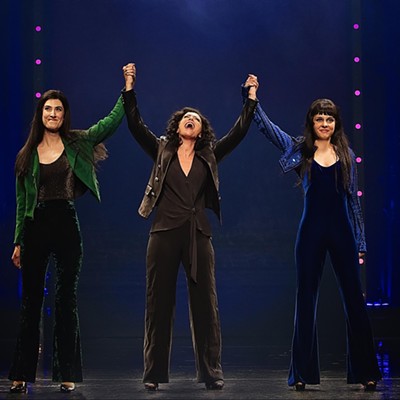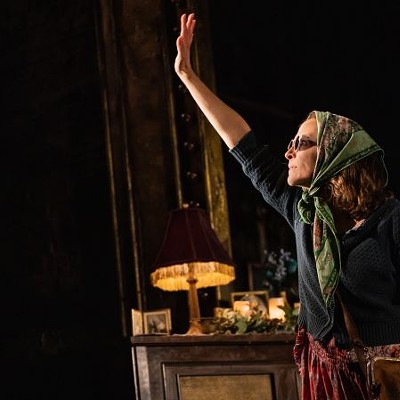Horror movies come in many different flavors, from truly dark and disturbing films like The Exorcist to comedy crossovers such as the Evil Dead sequels. Horror trends come and go, as any fan of scary movies can confirm. For instance, we're still knee-deep in zombie and found-footage films, with no end anywhere in sight.
One type of film that was hugely influential on the horror genre, and that many American fans are largely unaware of, is the "giallo." The word means "yellow" in Italian, and refers to a type of thriller that has literary origins stretching back to the late 1920s, when a series of crime-mystery pulp novels were published. All the books had lurid yellow covers, and they were successful enough that the format was copied by other companies. Soon "giallo" became a synonym for mystery novels in Italy.
While the literary format that preceded it was wrapped in yellow, the giallo films that began to appear in the mid-1960s were usually awash in another color — blood red. For a period of roughly 15 years, Italian filmmakers such as Mario Bava, Dario Argento and countless others pumped out violent and sexually charged thrillers that still pack a punch today. Giallos are hard to classify neatly, and vary greatly in tone and theme. They sometimes introduce supernatural elements in what would otherwise be straight crime mysteries, or veer into territory that would soon be borrowed and reinvented in American slasher films by directors like John Carpenter.
These films can be broadly characterized as violent murder-mystery thrillers, and usually a protagonist witnesses a gruesome murder and is drawn in to help solve the crime. The heroes are often outsiders who then slowly unravel the underlying mystery, as a vicious killer gets closer and closer to them.
A strong narrative and completely plausible plot are not always the main focus in these films, and it gives them a disorienting "otherness" that can be hard for some audiences to get used to. But they make up for loopy plot lines with style and sensory overload, and are well worth exploring, particularly if one has grown bored with the average American horror film. Here are a few good picks to give a person interested in giallos a taste of the genre. (Note: Some of the following trailers are NSFW. Viewer discretion is advised.)
6. Blood and Black Lace (1964)
When Mario Bava released this stylish film, it really got the giallo film genre rolling. Its a beautifully shot movie, with many of the stylistic and thematic characteristics that loosely define giallo films. A killer in a white mask is murdering models in an Italian fashion house, and Bava builds tension and mystery steadily. His previous film from 1963, The Girl Who Knew Too Much, is great, and considered by many to be the first true giallo, but Blood and Black Lace is a cut above.
5. The Bird With the Crystal Plumage (1970)
Building on the template that Bava and a few other directors created in the '60s, a young director named Dario Argento made his bones with this film, and established much of what '70s giallos would be. Stylish, scary and with a lot of eye candy, The Bird With The Crystal Plumage took the genre to another level of shock and mystery.
4. Twitch of the Death Nerve (1971)
This is another Mario Bava film, and one that was released under quite a few different titles, including A Bay of Blood. It's as stylized as the best of the giallo films, and is as graphically violent as the more gory slasher films that would be appearing a decade later. In fact, several death scenes in this movie were copied in Friday the 13th Part 2.
3. A Lizard in a Woman's Skin (1971)
Although Lucio Fulci is better known for hyper-gory films like Zombi 2 and The Beyond, he worked on all sorts of movies over his lengthy career, including a few notable giallos. In fact, it's those films that seem to have brought out the best in him, and went on to influence his later horror efforts. Describing A Lizard in a Woman's Skin is difficult, because of its dreamlike qualities, but it's a fine example of a '70s giallo, and should be considered a "must see" by any fan of the genre or of Fulci.
2. Deep Red (1975)
Many fans consider Suspiria to be Argento's best film, and while it is probably one of the greatest horror movies ever made, I prefer Deep Red (Or Profondo Rosso in Italian). This is where Argento was at his giallo peak, before making the slight stylistic jump to horror in Suspiria. His progression as a director is evident, as Argento's visuals became more intense, his set pieces more striking, and the overall sense of dread heavier than in his earlier films. This is also where the music Argento used became almost as important as what is shown on screen. The band Goblin created a spooky and mesmerizing score, and would continue to contribute music to the best of his films afterwards. This is my favorite giallo of all time, and its influence on American slasher films is obvious.
1. Tenebrae (1982)
This is a late entry into the giallo category, and although films that fit the genre are still occasionally made today, the true boom was really over by the '80s, and they have been largely replaced by the slasher films that they'd inspired. Slasher movies were a little less "weird" (usually) and a lot more tailored to the tastes of American audiences, and Tenebrae is definitely an Italian giallo rather than a slasher movie, although it's a particularly gory one. The plot is pure giallo, and will leave first-time audiences shocked at its bloody outcome.
Support Us
Houston's independent source of
local news and culture
account
- Welcome,
Insider - Login
- My Account
- My Newsletters
- Contribute
- Contact Us
- Sign out
[
{
"name": "Related Stories / Support Us Combo",
"component": "11591218",
"insertPoint": "4",
"requiredCountToDisplay": "4"
},{
"name": "Air - Billboard - Inline Content",
"component": "11591214",
"insertPoint": "2/3",
"requiredCountToDisplay": "7"
},{
"name": "R1 - Beta - Mobile Only",
"component": "12287027",
"insertPoint": "8",
"requiredCountToDisplay": "8"
},{
"name": "Air - MediumRectangle - Inline Content - Mobile Display Size 2",
"component": "11591215",
"insertPoint": "12",
"requiredCountToDisplay": "12"
},{
"name": "Air - MediumRectangle - Inline Content - Mobile Display Size 2",
"component": "11591215",
"insertPoint": "4th",
"startingPoint": "16",
"requiredCountToDisplay": "12"
}
,{
"name": "RevContent - In Article",
"component": "12527128",
"insertPoint": "3/5",
"requiredCountToDisplay": "5"
}
]
KEEP THE HOUSTON PRESS FREE...
Since we started the Houston Press, it has been defined as the free, independent voice of Houston, and we'd like to keep it that way. With local media under siege, it's more important than ever for us to rally support behind funding our local journalism. You can help by participating in our "I Support" program, allowing us to keep offering readers access to our incisive coverage of local news, food and culture with no paywalls.
Trending Arts & Culture
- Best Bets: Earth Day, Noche Caliente and a Spring Festival
- The Story Stalls But The Beat Goes On in The Cher Show at TUTS
- Using Flashbacks and Direct Quotes From the Classic Book, Alley Theatre Presents Jane Eyre
-
Sponsored Content From: [%sponsoredBy%]
[%title%]

Don't Miss Out
SIGN UP for the latest
arts & culture
news, free stuff and more!
Become a member to support the independent voice of Houston
and help keep the future of the Houston Press FREE
Use of this website constitutes acceptance of our
terms of use,
our cookies policy, and our
privacy policy
The Houston Press may earn a portion of sales from products & services purchased through links on our site from our
affiliate partners.
©2024
Houston Press, LP. All rights reserved.




